SouthEast Connector
Connecting Communities. Restoring the Environment. Creating Prosperity. Protecting the Eastern Sierra watershed.
Project Overview
The SouthEast Connector is significant regional investment in the Truckee Meadows that began over 40 years ago, and addresses the long-term transportation needs to improve the safety and mobility of people, goods, and services in the Reno/Sparks area. Completed in July June of 2018, the SouthEast Connector roadway— called Veterans Parkway—stretches 5.5 miles from the intersection of Greg Street and Sparks Boulevard, to the existing intersection of Veterans Parkway and South Meadows Parkway. In addition to the important transportation and economic benefits, the SEC project included a large plan to enhance wetland resources to protect the sensitive Truckee River ecosystem fed from several watershed systems of the Eastern Sierras while ensuring environmental regulations were met or exceeded.
